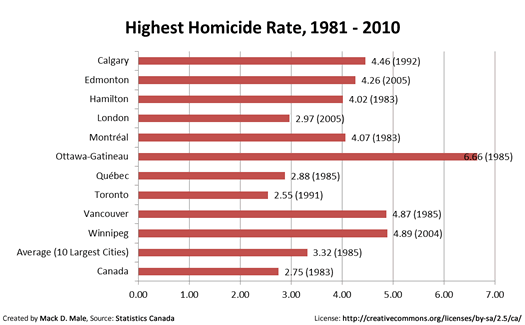About a month ago I shared some statistics about Edmonton’s homicide rate. As an initial effort, I think I got my point across: the homicide rate in Edmonton over the last thirty years has been trending downward and is not that different from other large cities in Canada. I have since done some additional research on this subject and would like to share what I have learned.
The graphs below generally compare the ten largest census metropolitan areas in Canada. I have used the homicide rate (the number of homicides per 100,000 people in the CMA) to compare rather than the absolute number of homicides. Where appropriate, I have included the overall Canadian rate and the average of the ten largest CMAs. The data all comes from Statistics Canada (the 2010 information is here). You can click on any graph to see a larger version.
Here are the homicide rates over the last thirty years:
You can see a few spikes (for Ottawa-Gatineau and Winnipeg in particular) but overall the rates are all pretty similar.
Here are the highest recorded homicide rates:
Nearly every location has had spikes at one time or another. But a few places consistently record the highest homicide rates:
You can see that Winnipeg has recorded the highest homicide rate among large cities the most, followed by Ottawa-Gatineau. Edmonton has recorded the second highest homicide rate among large cities most often, followed by Vancouver.
Here are the average homicide rates over the last thirty years:
Half of the ten largest cities are below the Canadian average. As a result, the average for the ten largest cities isn’t that much higher than the Canadian average.
Here is Edmonton’s homicide rate compared against the overall rate in Canada and the average of the ten largest cities. You can see that is trending downward, despite spikes in 2005/2006:
Over the last thirty years, Edmonton has never recorded a homicide rate lower than the Canadian rate. Only three times has Edmonton’s homicide rate been lower than the average for the ten largest cities:
As homicide rates in Canada have generally been trending downward, I thought it would be useful to look at the rates by decade. Here are the average homicide rates by decade since 1981:
You can see that with the exception of Winnipeg, every location recorded a lower average homicide rate in the period 2001-2010 than they did in the period 1981-1990.
This graph shows the change a little more clearly:
Every location’s average rate decreased in the 1990s. Only three locations (Edmonton, London, and Winnipeg) have recorded increases since 2000, and only Winnipeg’s was enough to increase past 1990 levels.
What’s next?
Today, our city’s new violence reduction action plan was unveiled. You can read the whole thing in PDF here. The report concludes:
The problem of violence in society is complex and multi-faceted. It requires diligent, ongoing coordinated work across a number of agencies and organizations. This includes other orders of government, who have information and resources that will be required in order that solutions be comprehensive, and sustainable over the long-term.
The City and its key partners will continue their efforts to understand and address the root causes of violence and maintain order and safety in our community, keeping the livability of Edmonton among the best in Canada and the world.
I think understanding where we’re at is an important part of unraveling this mystery. Hopefully the information I have shared above will help in that regard. I look forward to the community conversations slated to take place this fall.
In a follow-up post, I’ll take a closer look at Edmonton’s homicide rate in the context of our demographics, economic situation, and other factors.








That’s it, I am officially cancelling my Edmonton Sun subscription. Thanks for the hard work Mack.
Glad you found it useful!
A homicide rate of ~3/100k isn’t exactly a “sky is falling” type of a situation that some would have us believe, but we should still strive to do better. Calgary is similar in size and location, yet consistently achieves lower rates.
I agree with you. Just because our murder rates are 5 to 10 times better than a country like the United States is no reason to be complacent. One murder anywhere is too many.
Statistics can be an odd thing to grasp the meaning of, and sometimes just a relative bad measure against even worse conditions somewhere else. ie. If murder rates in the United States were .15/100k to .3/100k (approx 10 times lower than Canada) we would be screaming at our politicians right now to do something drastic, and fast!!
winnipeg is by far the most dangeorus city in canada basiaslly every year
Yes, great work Mack in compiling data that flies in the face of what some politician’s will have us believe. It is interesting that the largest cities like Montreal. Vancouver and Toronto often have lower murder rates than some much smaller urban areas like Ottawa and Winnipeg. I wonder how much that has to do with access to major trauma care in a timelier fashion? Does someone being shot or stabbed in Toronto stand a greater chance of survival than someone being shot in Winnipeg, etc?
Did you ever do a followup post about demographics, economics, and other contextual details for homicides? I can’t find it here via search.
I didn’t end up doing that follow-up post, no!